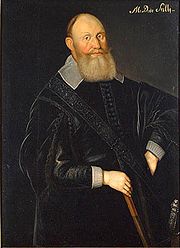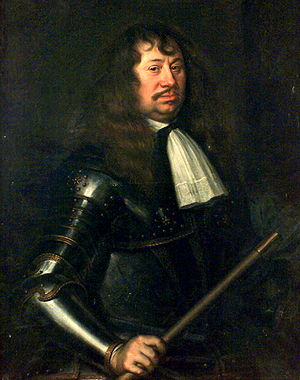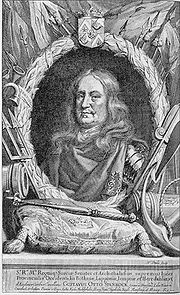
Lord High Admiral of Sweden
Encyclopedia
The Lord High Admiral or Admiral of the Realm (Swedish: Riksamiral) was a prominent and influential office in Sweden, from c. 1571 until 1676, excluding periods when the office was out of use. The office holder was a member of the Swedish Privy Council
and the head of the navy and Admiralty of Sweden. From 1634, the Lord High Admiral was one of five Great Officers of the Realm
.
 The origin of the title "Lord High Admiral of Sweden" can be traced to the reign of king Eric XIV and the year 1561 or possibly 1562. An överste amiral (approximately "colonel admiral") is assigned to be responsible for the Swedish fleet. In practice, however, this office meant not, as it was supposed to from the beginning, caring for the administration concerning the fleet, for example constructing and equipping it. Eric's successor, younger brother John III
The origin of the title "Lord High Admiral of Sweden" can be traced to the reign of king Eric XIV and the year 1561 or possibly 1562. An överste amiral (approximately "colonel admiral") is assigned to be responsible for the Swedish fleet. In practice, however, this office meant not, as it was supposed to from the beginning, caring for the administration concerning the fleet, for example constructing and equipping it. Eric's successor, younger brother John III
, appointed Clas Fleming
riksamiral, probably in 1571, and once again it was intended that the office would mean administration, and not just a commanding role in the occasion of naval warfare. Fleming stood on king Sigismund
's side during the conflict against Duke Charles in the 1590s. When Charles eventually took over as king (as Charles IX) in the early 17th century, a Lord High Admiral was included among the higher office-holders.

 In the 1610s, during Göran Gyllenstierna's period as Lord High Admiral, the office began to mean specific assignments in a more regular way than before. An admiralty
In the 1610s, during Göran Gyllenstierna's period as Lord High Admiral, the office began to mean specific assignments in a more regular way than before. An admiralty
(Amiralitetet) was established that was introduced as one of five branches of the Swedish government in 1634 (under a new name; Amiralitetskollegium). The heads of the five departments were called Great Officers of the Realm
and were the five most prominent members of the Swedish Privy Council
. Lord High Admiral, one of these five officers, was third in rank in the quintet.
In 1676, the office was abolished. Gustaf Otto Stenbock
, the holder of the office at that time, received the title överste amiral instead. When Stenbock died in 1685, this title was withdrawn as well. King Charles XI
, who had come to age in 1672, wanted to avoid appointing new holders of the high offices, once these became vacant. The riksamiral title has not been used since, in contrast to two other offices that Charles XI abolished, Lord High Chancellor
and Lord High Steward
, who were both revived for a relatively short period in the late 18th century.
Privy Council of Sweden
The High Council of Sweden or Council of the Realm consisted originally of those men of noble, common and clergical background, that the king saw fit for advisory service...
and the head of the navy and Admiralty of Sweden. From 1634, the Lord High Admiral was one of five Great Officers of the Realm
Great Officers of The Realm
The Great Officers of the Realm were the five leading members of the Swedish Privy Council from the later parts of the 16th century to around 1680. With the constitution of 1634, the five officers became heads of five different branches of government...
.
History

John III of Sweden
-Family:John married his first wife, Catherine Jagellonica of Poland , house of Jagiello, in Vilnius on 4 October 1562. In Sweden, she is known as Katarina Jagellonica. She was the sister of king Sigismund II Augustus of Poland...
, appointed Clas Fleming
Klaus Fleming
Baron Clas Eriksson Fleming was a Finnish-born member of the Swedish nobility and admiral, who played an important role in Finnish and Swedish history during the rise of Sweden as a Great Power...
riksamiral, probably in 1571, and once again it was intended that the office would mean administration, and not just a commanding role in the occasion of naval warfare. Fleming stood on king Sigismund
Sigismund III Vasa
Sigismund III Vasa was King of Poland and Grand Duke of Lithuania, a monarch of the united Polish–Lithuanian Commonwealth from 1587 to 1632, and King of Sweden from 1592 until he was deposed in 1599...
's side during the conflict against Duke Charles in the 1590s. When Charles eventually took over as king (as Charles IX) in the early 17th century, a Lord High Admiral was included among the higher office-holders.


Admiralty (disambiguation)
-Naval organizations:Russia*Russian Admiralty, the authority responsible for the Imperial Russian NavyUnited Kingdom*Admiralty, the authority responsible for HM Royal Navy before 1964*United Kingdom Hydrographic Office produces the Admiralty brand of charts....
(Amiralitetet) was established that was introduced as one of five branches of the Swedish government in 1634 (under a new name; Amiralitetskollegium). The heads of the five departments were called Great Officers of the Realm
Great Officers of The Realm
The Great Officers of the Realm were the five leading members of the Swedish Privy Council from the later parts of the 16th century to around 1680. With the constitution of 1634, the five officers became heads of five different branches of government...
and were the five most prominent members of the Swedish Privy Council
Privy Council of Sweden
The High Council of Sweden or Council of the Realm consisted originally of those men of noble, common and clergical background, that the king saw fit for advisory service...
. Lord High Admiral, one of these five officers, was third in rank in the quintet.
In 1676, the office was abolished. Gustaf Otto Stenbock
Gustaf Otto Stenbock
Count Gustaf Otto Stenbock was a Swedish soldier and politician.He was son of Friherre Gustav Eriksson Stenbock and Countess Beata Margareta Brahe , born in Torpa, Länghem parish, Tranemo Municipality, Västergötland, Sweden.He was appointed head of Kronobergs regemente in 1637, Major General in...
, the holder of the office at that time, received the title överste amiral instead. When Stenbock died in 1685, this title was withdrawn as well. King Charles XI
Charles XI of Sweden
Charles XI also Carl, was King of Sweden from 1660 until his death, in a period in Swedish history known as the Swedish empire ....
, who had come to age in 1672, wanted to avoid appointing new holders of the high offices, once these became vacant. The riksamiral title has not been used since, in contrast to two other offices that Charles XI abolished, Lord High Chancellor
Lord High Chancellor of Sweden
The Lord High Chancellor was a prominent and influential office in Sweden, from 1561 until 1680, excluding periods when the office was out of use. The office holder was a member of the Privy Council of Sweden...
and Lord High Steward
Lord High Steward of Sweden
The Lord High Steward or Lord High Justiciar was a highly prominent member of the Swedish Privy Council from the 13th century until 1809, excluding periods when the office was out of use....
, who were both revived for a relatively short period in the late 18th century.
Lord High Admirals of Sweden
- Clas (Eriksson) FlemingKlaus FlemingBaron Clas Eriksson Fleming was a Finnish-born member of the Swedish nobility and admiral, who played an important role in Finnish and Swedish history during the rise of Sweden as a Great Power...
(1571? 1588?-1595?) - Axel (Nilsson) Ryning (1602-1611)
- Göran Gyllenstierna (1612-1618)
- Carl (Carlsson) Gyllenhielm (1620-1650)
- Gabriel (Bengtsson) Oxenstierna (1652-1656)
- Carl Gustav Wrangel (1657-1664)
- Gustaf Otto StenbockGustaf Otto StenbockCount Gustaf Otto Stenbock was a Swedish soldier and politician.He was son of Friherre Gustav Eriksson Stenbock and Countess Beata Margareta Brahe , born in Torpa, Länghem parish, Tranemo Municipality, Västergötland, Sweden.He was appointed head of Kronobergs regemente in 1637, Major General in...
(1664-1676)

